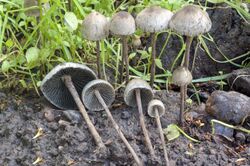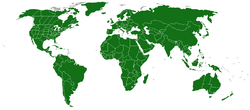Biology:Panaeolus papilionaceus
| Panaeolus papilionaceus | |
|---|---|

| |
| Scientific classification | |
| Kingdom: | |
| Phylum: | |
| Class: | |
| Order: | |
| Family: | |
| Genus: | |
| Species: | P. papilionaceus
|
| Binomial name | |
| Panaeolus papilionaceus (Bull. ex Fries) Quélet
| |

| |
| Approximate range of Panaeolus papilionaceus var. papilionaceus | |
| Synonyms | |
|
Agaricus calosus | |
| Panaeolus papilionaceus | |
|---|---|
| Mycological characteristics | |
| gills on hymenium | |
| cap is convex | |
| hymenium is adnexed | |
| stipe is bare | |
| spore print is black | |
| ecology is saprotrophic | |
| edibility: inedible | |
Panaeolus papilionaceus, also known as Agaricus calosus, Panaeolus campanulatus, Panaeolus retirugis,[1] and Panaeolus sphinctrinus,[1] and commonly known as Petticoat mottlegill, is a very common and widely distributed little brown mushroom that feeds on dung.
This mushroom is the type species for the genus Panaeolus.
Description
- Cap: 1–5 cm across, obtusely conic, grayish brown,[1] not hygrophanous, becoming campanulate in age, margin adorned with white toothlike partial veil fragments when young or towards the edge,[1] flesh thin.
- Gills: adnate to adnexed close to crowded, one or two tiers of intermediate gills, pale gray, acquiring a mottled, blackish appearance in age, with whitish edges.
- Spores: 12–18 x 7–10 µm, elliptical, smooth, with an apical pore, spore print black.
- Stipe: 6–12 cm by 2–4 mm, gray-brown to reddish brown, darker where handled, paler toward the apex, brittle,[1] fibrous, and pruinose.
- Odor: Mild.
- Taste: Unappetizing.
- Microscopic features: Basidia 4-sterigmate; abruptly clavate. Cheilocystidia abundant; subcylindric, often subcapitate or capitate.
Habitat and formation
Occurring singly, gregariously, or caespitosely on cow/horse dung, moose droppings, and in pastures. Widely distributed in North America throughout the year, but only in warmer climates in winter. It can be found in countries including[2] Canada (Alberta,[3] British Columbia), the United States (Alabama, Alaska, California ,[3] Colorado, Florida, Georgia,[3] Indiana ,[3] Louisiana,[3] Maine, Massachusetts , Missouri, Montana,[3] New Mexico, New York, Oklahoma, Texas ,[3] Washington (state) [3]), the Caribbean (Bahamas, Cuba, San Vincent Island), Chile , Colombia, Uruguay, France , The Netherlands, Greece, Mexico,[3] Norway , Slovenia,[3] South Africa , Uganda, China , Iran, Lithuania, Kuwait, and the Philippines .
Edibility
Panaeolus papilionaceus is inedible,[4] and is neither choice in flavor nor substantial in mass. While similar looking species, such as Psilocybe mexicana, do contain psilocybin, Panaeolus papilionaceus does not.[5]
Gallery
See also
References
- ↑ 1.0 1.1 1.2 1.3 1.4 Trudell, Steve; Ammirati, Joe (2009). Mushrooms of the Pacific Northwest. Timber Press Field Guides. Portland, OR: Timber Press. pp. 201. ISBN 978-0-88192-935-5. https://books.google.com/books?id=WevHvt6Tr8kC.
- ↑ Worldwide Distribution of Neurotropic Fungi, Guzman (www.museocivico.rovereto.tn.it)
- ↑ 3.0 3.1 3.2 3.3 3.4 3.5 3.6 3.7 3.8 3.9 Panaeolus papilionaceus The Mushroom Observer (mushroomobserver.org)]
- ↑ Phillips, Roger (2010). Mushrooms and Other Fungi of North America. Buffalo, NY: Firefly Books. p. 236. ISBN 978-1-55407-651-2.
- ↑ Allen, John W. (2013). Ethnomycological Journals: Sacred Mushroom Studies Volume IX. Santa Cruz, California and Seattle, Washington, respectively: MAPS and Exotic Furays. pp. 130–175. ISBN 978-158-214-396-5.
External links
- Mushroom Expert - Panaeolus papilionaceus
- Mykoweb - Panaeolus papilionaceus
- Observations on Mushroom Observer
Wikidata ☰ Q2484523 entry
 |






